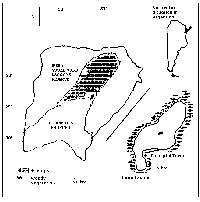 |
Last Update:
Friday November 23, 2018
|
| [Home] |
|
Volume 8 Pages 1 - 47 (February 1993) Citation: Parera, A. (1993) The Neotropical River Otter Lutra longicaudis in Iberá Lagoon, Argentina. IUCN Otter Spec. Group Bull. 8: 13 - 16 The Neotropical River Otter Lutra longicaudis in Iberá
Lagoon, Argentina Proyecto Ariraí, Virrey Cevallos 215 4º C, 1077 Buenos Aires, Argentina
Very little is known about the neotropical river otter, Lutra longicaudis in Argentina, as in other Latin-American countries inhabited by the species. Some reports came from Mexico (Gallo 1986, 1989), Brazil (Blacher 1987, Olimpio 1992). and recently Uruguay (Bardier 1992a, b). This widely ranged otter has suffered a high hunting pressure in the current century, for its pelt, and has disappeared from many areas where it was abundant in Argentina. But in the last two decades the hunting decreased, and otter populations seem to have recovered in parts of its original range. Currently, one of the most profitable habitats of the neotropical otter in Argentina is the Iberá Swamps and Lagoons Reserve, an important wetland system in the northeast of the country. THE AREA The Iberá Swamps and Lagoons Reserve (13 000 km2) is situated in Corrientes province (Figure 1). The environment consists basically of a vast green extension of aquatic and semi-aquatic vegetation (Scirpus californicus, Cyperus giganteus, Fuirena robusta, Thalia multiflora, Typha spp.), interrupted by several clearwater ponds, blocked short streams, and lagoons of 3-5 m deep. A particular low density floating soil, locally known as "embalsado" is the substratum of a poorly distributed woody vegetation (Erithryna crista-galli, Nectandra falcifolia, Sapium haematospermum Neill 1981).
In the Iberá Lagoon - where the local authorities put their major conservation effort - otters have recovered since the ban on hunting in the early 1980s. In this report I'll summarise the most important points after six visits to the area (1989-1992). DIURNAL ACTIVITY The otters show little fear and can be observed during daylight. During journeys searching for otters by canoe, I got an average of one sighting every 1-3 hours. Foraging activities occur all day, but were more frequent in the middle and late afternoon. Most of the sightings were of lone animals. Groups always consisted of a female with her cubs (1 or 2 in all cases recorded). Nocturnal activity was recorded once. Tomás Waller, searching for caimans at night, told me he had never seen otters in his nocturnal surveys, using potent spotlights. I think otters could move nocturnally. but it is difficult to detect them without telemetry. FOOD HABITS Foraging behaviour is similar to that described for the European otter (Erlinge 1968, Mason & Macdonald 1986). Smaller prey items are consumed in the water, making several swallowing head movements at the surface, and large ones are grabbed with the claws and taken ashore. Food availability seems to be high in the lagoon, and otters are successful in their dives (e.g. I saw an adult female with her one-year-old cub pursuing and catching six different sized fish in twenty minutes). An analysis of an initial spraint sample (n = 46) shows mainly fish (relative frequency = 85 %), consisting of Cichlidae (34,5 %), Erithrinidae (16 %) and O. siluriformes (13,5 %). Crabs seam to be an important item, more in winter (13,4 %) than in summer (3,9 %). Molluscs, reptiles and rodents are much less important (Parera 1992). Fast-moving fish, like the aggressive and more abundant piranha (Serrasalmus spp.) seems to be avoided by the otters. SPRAINTING Lutra longicaudis seems to prefer solid, dry and high platforms for sprainting, e.g. root systems of Nectandra falcifolia, rocks of an artificial embankment, and planks under a bridge. Where these surfaces are not available, otters spraint on the embalsado, humid, and frequently flooded surface. Sprainting is more important during the winter season (e.g. at an exceptional sprainting site I found more than 50 faeces in the winter and only one in the summer). Green jelly-like secretions (as those described for Lutra lutra) were frequently found in the winter, but scarce in the summer. NUMBERS In Iberá lagoon otters are frequently seen, approaching 5-6 m from the observer, uttering their typically inquisitive "hahh". This allowed us to count otters directly, using a linear transect method. In collaboration with the Reserve Guardians I made partial and total counts along the Lagoon perimeter (54,5 km), and estimate a number 80-140 otters living along the shoreline. The otter density is high - similar to those found from other Lutra living in coastal habitats - (Kruuk et al, 1987; Beja 1991), which points out the high productivity of the system (Parera 1993). CONSERVATION By the 1970s the Lutra longicaudis population of the Iberá area (not only the lagoon) was very low due to the excessive illegal hunting. As local people told me "to find an otter was almost impossible". Since 1983, when the area became a wild-life reserve and the authorities emphasized their efforts to control the lagoon, the otter population recovered rapidly. The same occurs in several other lagoons in the reserve, but not in the total area because hunting is not controlled in most of the large extension of the reserve (official financial support is the major problem). As this is the most important area for this otter, conservation efforts should be strengthened. ACKNOWLEDGEMENTS - I thank Dr Pedro Pere Muñoz and Dr Vincente Fraga, Directors of the Iberá Reserve, and all staff who assisted me in the field. The work was possible thanks to FUCEMA and Dirección Nacional de Fauna Silvestre. I thank Dr Pablo Oliva for his interest and assistance. REFERENCES Bardier, G. (1992)a. Uso de recursos
y características del Hábitat de Lutra longicaudis en el arroyo
Sauce, Uruguay. Bol. Soc. Zool. Uruguay (2° épocal) 7:
59-60 |
| [Copyright © 2006 - 2050 IUCN/SSC OSG] | [Home] | [Contact Us] |
